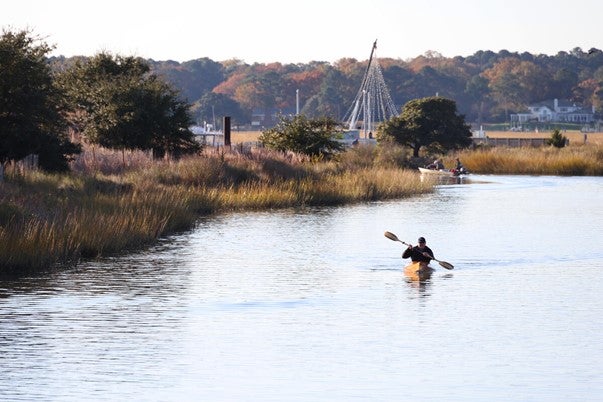Wetlands can be powerhouses for climate adaptation and resilience. This World Wetlands Day, we are highlighting one type of wetland that impacts people the most – coastal urban wetlands.
Wetlands in the right place at the right time
According to NOAA, nearly 40% of people in the US live in coastal counties, and the coastal wetlands in these communities play an important role for people who live, work and play near the coast. In addition to a laundry list of indirect benefits – storing carbon, improving water quality and supporting biodiversity – this collection of salt and brackish marshes provides benefits directly to people because they are near them.
Coastal urban wetlands protect properties against flooding and filter out excess nutrients from urban runoff that would otherwise fuel harmful algal blooms. They are integral to the health of coastal ecosystems through their function as a nursery ground for coastal food webs, making their presence a boon for coastal industries like tourism, fisheries and recreation.
A mixed outlook for coastal urban wetlands if we do nothing
While coastal urban wetlands are vital, they are also some of the most threatened wetlands due to direct human actions and climate change. The most recent projections from NOAA show that sea level for US coastlines will likely rise over a foot in the next 30 years – and nearly 4 feet by 2100. Coastal wetlands can grow vertically to keep up with sea level rise, but only with the right salinity and sediment conditions. Wetlands can also move ashore in what’s called upland migration, but hardened shorelines in urban areas can block this landward movement.
To preserve these and other important coastal wetlands, we need to take bold action. Here’s how:
1. Prioritize natural infrastructure over grey infrastructure to restore and create coastal wetlands.
In many cases, natural infrastructure, like coastal wetlands and living shorelines, can do the same job as hardened grey infrastructure like bulkheads at a fraction of the cost. Not only are natural infrastructure practices cheaper, but they can also be more resilient to storm events because of their ability to regenerate and build elevation.
New large-scale flood protection projects should prioritize the use of wetlands and other natural infrastructure over grey infrastructure, and when grey solutions are necessary, combine them with natural infrastructure in hybrid approaches to maximize community benefits. On a smaller scale, many hardened shorelines like bulkheads can be replaced or combined with living shorelines that are not blocked from migrating upland. Existing marshes can also be protected from erosion using natural infrastructure practices such as oyster sills, and the additional wave dampening can help them grow vertically faster.
With the widespread implementation of natural infrastructure practices, we can increase community flood protection, increase our current wetland area and help coastal wetlands better adapt to climate change.
2. Maximize the utility of land acquired through floodplain buy-outs.
Using coastal flood-prone land to implement natural infrastructure, including wetlands, would be valuable to communities. Some coastal communities or states implement their own buy-out programs, like New Jersey’s Blue Acres program. Elsewhere, states coordinate with FEMA to buy flood-prone properties and help people relocate safely.
A common problem that communities face is what to do with the property after a buyout. By putting natural infrastructure on acquired land, municipalities can lower their coastal flood risk, expand wetland areas and potentially lower the costs associated with maintaining otherwise-vacant land. If the land is used for stormwater management, municipalities may also receive payment for mitigation credits from their state. Finally, these acquired properties could also function as public parks to provide additional value to the surrounding community. People moving out of flood-prone areas is a difficult issue, but maximizing acquired property to better protect the community from flooding is a smart choice.
3. Take action to address climate change.
Reducing the greenhouse gas emissions that drive sea level rise will also make it easier for coastal urban wetlands to adapt. Marshes can build up and move landward to keep up with sea level rise, but they can only go so fast. Prioritizing climate mitigation to minimize or avoid the most drastic impacts of climate change will help marshes adapt and increase coastal resilience.
Coastal urban wetlands live on the edge in more ways than one, but these ecosystems are too important to lose. This World Wetlands Day, let’s focus on these three actions to help preserve, restore and grow our coastal urban wetlands.










